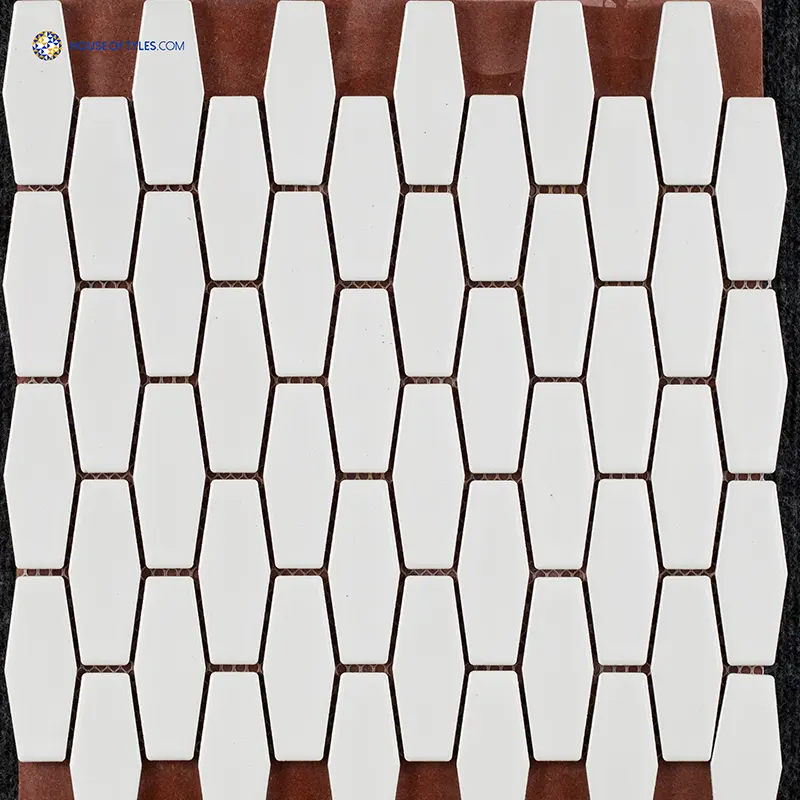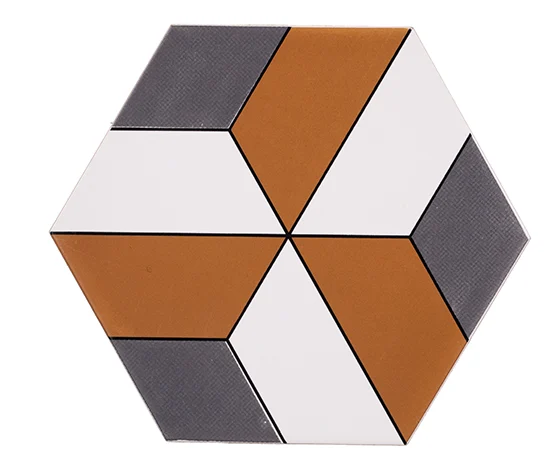1. CERAMIC TILES
Description: Made from clay that is fired at high temperatures, ceramic tiles are one of the most popular types of tiles used in residential and commercial spaces.
Subtypes:
Glazed Ceramic Tiles: Have a glass-like coating that provides a waterproof and stain-resistant surface. Available in a wide range of colors and patterns.
Unglazed Ceramic Tiles: Have a more natural, matte finish and are less water-resistant. They may require sealing.
Applications: Walls, floors, backsplashes, and countertops in areas with moderate moisture.

2. PORCELAIN TILES
Description: A type of ceramic tile made from a finer clay and fired at higher temperatures, making it denser and less porous than standard ceramic tiles.
Subtypes:
Glazed Porcelain Tiles: Feature a protective glaze that makes them highly resistant to water, stains, and scratches.
Unglazed Porcelain Tiles: Have the same color throughout and are durable but require sealing to prevent staining.
Applications: Floors and walls in high-traffic and high-moisture areas, including bathrooms, kitchens, and outdoor spaces.
3. VITRIFIED TILES
Description: Made by blending clay with silica, quartz, and feldspar and fired at high temperatures. They are dense and non-porous.
Subtypes:
Full-Body Vitrified Tiles: Have the same color and pattern throughout the tile, offering durability and resistance to wear.
Glazed Vitrified Tiles (GVT): Feature a glazed surface that adds visual appeal and further enhances water resistance.
Applications: Ideal for residential and commercial flooring, including high-traffic areas.
4. GLASS TILES
Description: Made from glass and often used for their reflective and colorful properties. They are available in various finishes and sizes.
Subtypes:
Clear Glass Tiles: Offer a glossy and transparent finish.
Frosted Glass Tiles: Have a matte finish and are less reflective.
Textured Glass Tiles: Provide a unique surface texture.
Applications: Backsplashes, shower walls, and accent features. Suitable for both wet and dry areas.
5. NATURAL STONE TILES
Description: Tiles made from natural stone, offering unique patterns and textures. Common types include granite, marble, limestone, travertine, and slate.
Subtypes:
Granite Tiles: Known for their durability and resistance to scratches and heat.
Marble Tiles: Offer a luxurious appearance with natural veining; they require sealing to prevent staining.
Limestone Tiles: Provide a soft, warm look but are more porous and require sealing.
Travertine Tiles: Feature a distinctive texture and are suitable for both indoor and outdoor use when properly sealed.
Slate Tiles: Known for their rugged texture and durability; they can be slippery when wet and may require sealing.
Applications: Floors, walls, countertops, and outdoor areas.
6. TERRAZZO TILES
Description: Made from a mixture of marble, granite, quartz, or glass chips set in a cement or resin base. They are known for their durability and aesthetic appeal.
Subtypes:
Cement-Based Terrazzo: Traditional terrazzo with a cement matrix.
Resin-Based Terrazzo: Uses a resin binder for a more flexible and lighter tile.
Applications: Floors and walls in high-traffic areas, commercial spaces, and residential interiors.
7. ENCAUSTIC CEMENT TILES
Description: Made from a mixture of cement, sand, and pigments, these tiles have patterns embedded into the surface rather than applied as a glaze.
Applications: Used for decorative floors and walls in areas where a unique, hand-crafted look is desired. They require sealing to protect against moisture.
8. TERRACOTTA TILES
Description: Made from natural clay and often left unglazed, these tiles have a warm, earthy appearance.
Applications: Best for indoor areas or covered outdoor spaces. They require sealing to enhance their water resistance and prevent staining.
9. SUBWAY TILES
Description: Rectangular tiles known for their classic, simple design. Often used in a 3×6 inch size, but available in various dimensions and finishes.
Applications: Commonly used for backsplashes, bathroom walls, and other vertical surfaces. They are available in both glazed and unglazed versions.
10. MOSAICS
Description: Small tiles, typically 1×1 inch or smaller, arranged in patterns or designs. They can be made from various materials, including glass, ceramic, and stone.
Applications: Used for decorative accents, backsplashes, shower walls, and artistic installations.
11. LARGE FORMAT TILES
Description: Tiles larger than standard sizes (e.g., 12×12 inches), available in various materials such as porcelain, ceramic, and stone.
Applications: Ideal for creating a seamless look on floors and walls. They are popular for contemporary and minimalist designs.
12. QUARRY TILES
Description: Made from unglazed clay and fired at high temperatures, these tiles are durable and have a natural, earthy finish.
Applications: Used in commercial settings, industrial spaces, and residential kitchens or utility rooms where durability is essential.
13. METAL TILES
Description: Made from materials like stainless steel, aluminum, or copper. Metal tiles are known for their modern, sleek look.
Subtypes:
Stainless Steel Tiles: Offer a contemporary and durable finish. They are resistant to moisture and stains but can show fingerprints and require regular cleaning.
Copper Tiles: Provide a unique, warm appearance that can develop a patina over time.
Applications: Often used in modern kitchens, backsplashes, and feature walls. Suitable for both residential and commercial spaces.
14. CEMENT TILES
Description: Made from a mixture of cement, sand, and pigments, cement tiles are known for their vibrant colors and intricate patterns.
Applications: Used for decorative flooring and wall applications. Ideal for spaces where a bold, artistic look is desired. They require sealing to protect against stains and moisture.
15. 3D TILES
Description: Feature three-dimensional patterns that create a textured surface. Made from materials such as ceramic, porcelain, or MDF (medium-density fiberboard).
Subtypes:
Ceramic 3D Tiles: Often glazed for added durability and ease of cleaning.
MDF 3D Tiles: Lightweight and often used for feature walls in dry areas.
Applications: Primarily used on feature walls, accent walls, or ceilings to add texture and visual interest.
16. PORCELAIN PAVERS
Description: Larger format tiles made from dense porcelain, designed specifically for outdoor use. They are highly durable and can mimic natural stone or wood.
Applications: Ideal for patios, driveways, and outdoor areas where high durability and resistance to weather are important.
17. VINYL TILES
Description: Made from synthetic materials and available in a range of styles, including those that mimic natural materials like wood or stone.
Subtypes:
Luxury Vinyl Tiles (LVT): Provide a high-quality, durable surface with realistic textures and patterns.
Standard Vinyl Tiles: More affordable and available in a variety of designs.
Applications: Suitable for residential and commercial spaces, including bathrooms and kitchens. Easy to install and maintain.
18. RESIN TILES
Description: Made from resin materials, often combined with natural aggregates like quartz or marble. They offer a smooth, modern appearance.
Applications: Used in both residential and commercial settings, including floors and walls. They are highly customizable and available in various colors and finishes.
19. SLATE TILES
Description: Made from natural slate rock, slate tiles are known for their rugged and textured surface.
Applications: Ideal for flooring in areas that require durability and a natural aesthetic. Suitable for both indoor and outdoor use. Requires sealing to prevent staining and moisture infiltration.
20. PENNY TILES
Description: Small, round tiles that are often arranged in a mosaic pattern. Made from materials like ceramic, glass, or metal.
Applications: Commonly used in bathrooms, backsplashes, and as accent features due to their distinctive and playful appearance.

21. HEXAGON TILES
Description: Six-sided tiles that create geometric patterns. Available in various materials including ceramic, porcelain, and natural stone.
Applications: Used on floors and walls to create modern, dynamic designs. Popular in contemporary and mid-century interiors.
22. DIAMOND TILES
Description: Tiles cut into diamond shapes. They can be made from various materials and are used to create distinctive patterns.
Applications: Often used as accent tiles or in combination with other tile shapes to add visual interest to a space.
23. Large Format Tiles
Description: Tiles that are larger than the standard sizes, such as 24×24 inches or even 48×48 inches. They can be made from materials like porcelain, ceramic, or natural stone.
Applications: Ideal for creating a seamless, modern look on floors and walls. They are often used in contemporary and minimalist designs.
24. MOSAIC TILES
Description: Small tiles arranged in a pattern or design. They can be made from various materials, including glass, ceramic, stone, and metal.
Applications: Often used as decorative accents or to create intricate designs on floors, walls, and backsplashes.
25. CLINKER TILES
Description: Made from a type of clay that is fired at very high temperatures. They are known for their durability and resistance to weathering.
Applications: Used in both residential and commercial settings, particularly in high-traffic areas or outdoor applications.
CONCLUSION
Choosing the right tile involves considering factors such as material properties, durability, aesthetic preferences, and specific application needs. From traditional ceramic and porcelain tiles to more specialized options like metal, glass, and mosaic tiles, each type offers unique benefits and design possibilities. Understanding these options can help you make an informed decision that suits your project’s requirements and enhances your space.